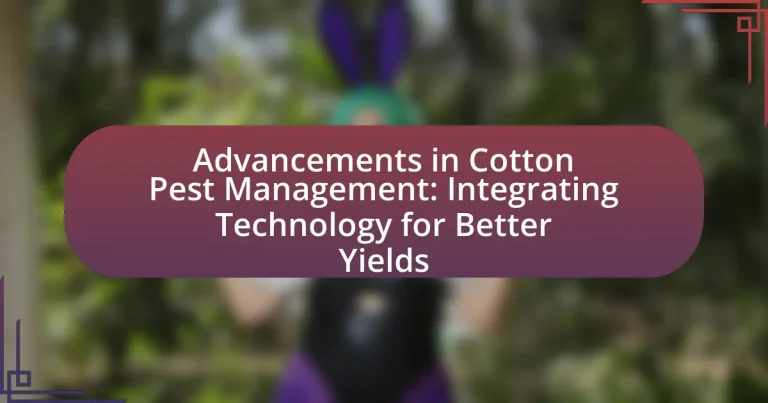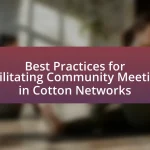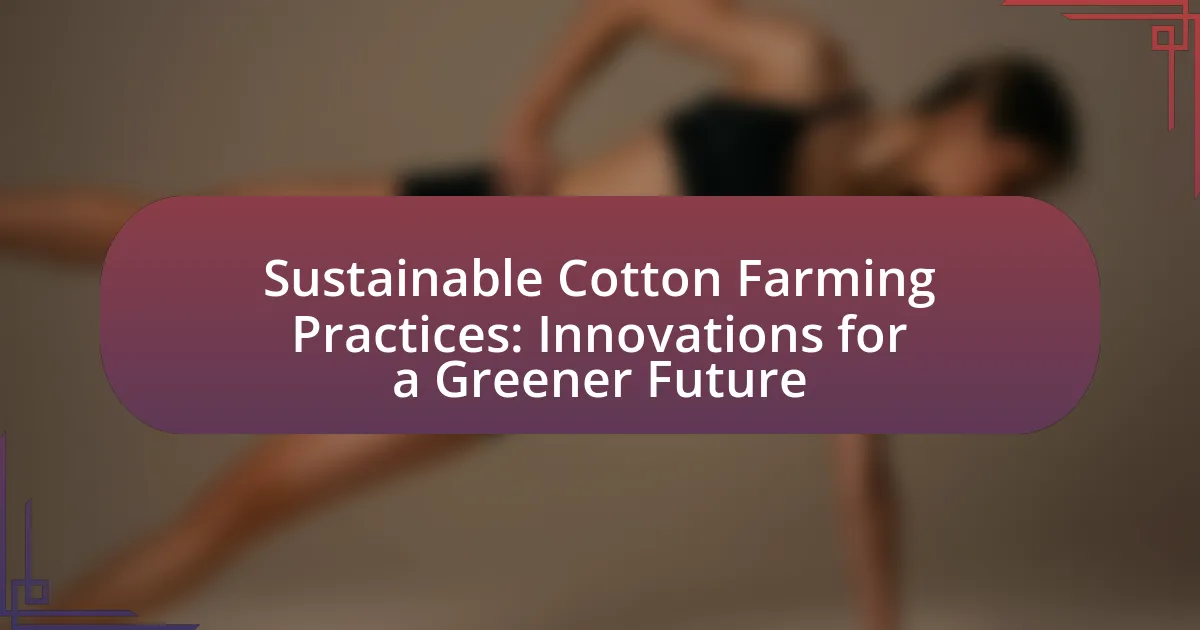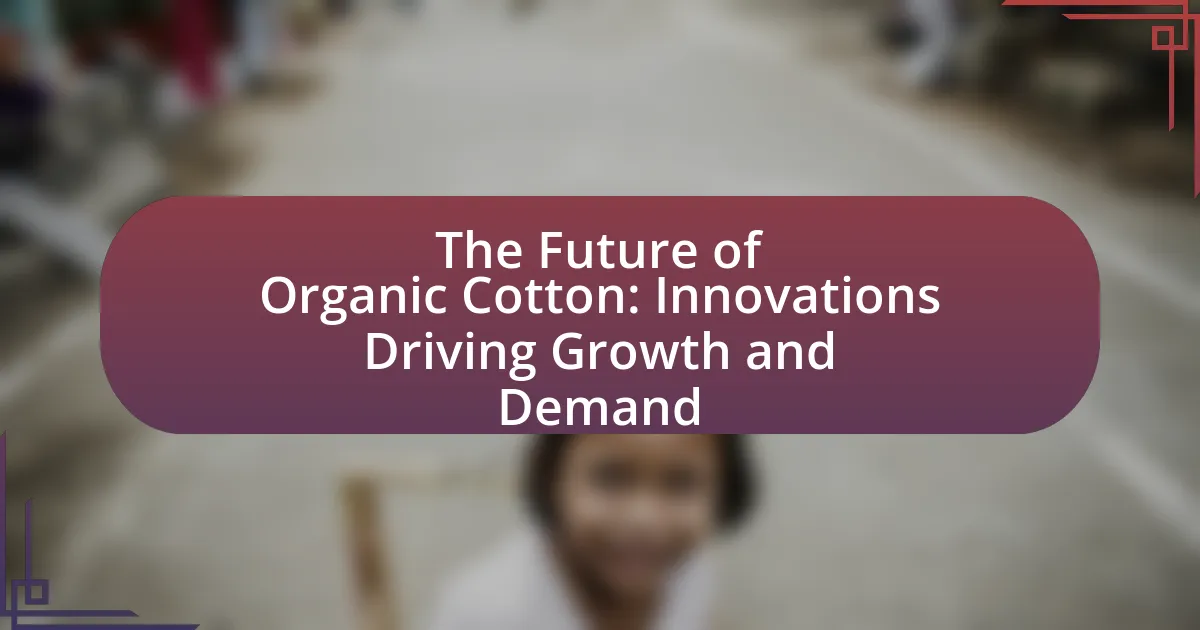The article focuses on recent advancements in cotton pest management, emphasizing the integration of technology to enhance agricultural practices and improve crop yields. Key developments include the use of precision agriculture tools, such as remote sensing and drones, which allow for accurate monitoring of pest populations and targeted pesticide application. Additionally, the article discusses the role of integrated pest management (IPM) strategies, biotechnology, and data analytics in addressing challenges like pest resistance and climate change. By adopting these innovative approaches, cotton farmers can achieve higher productivity while minimizing environmental impact.
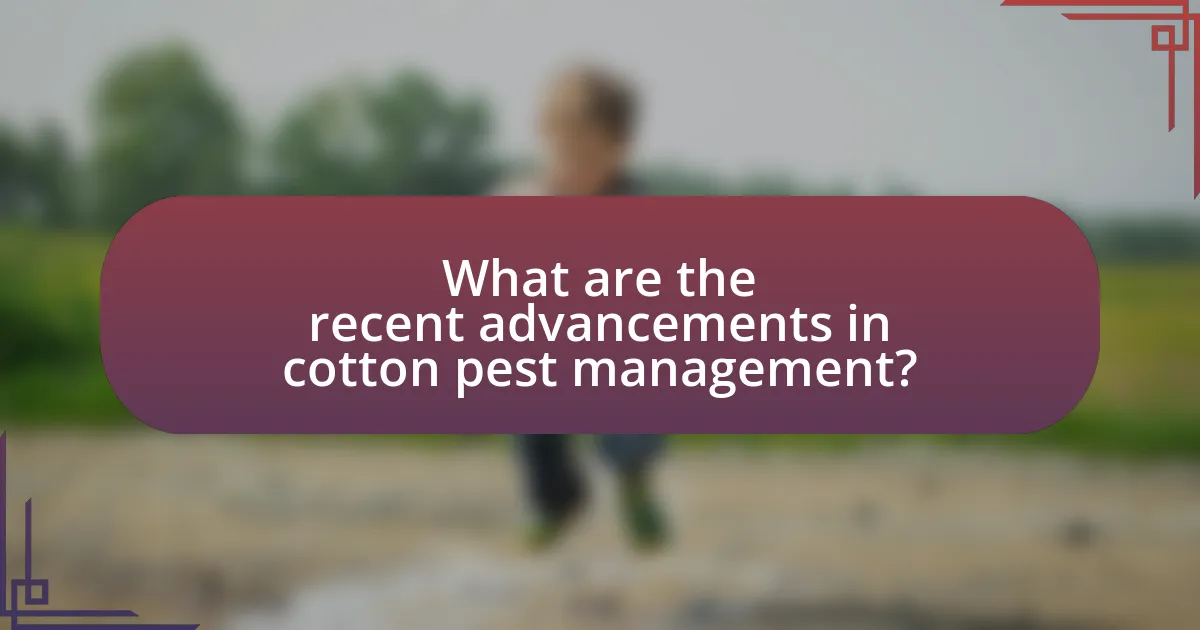
What are the recent advancements in cotton pest management?
Recent advancements in cotton pest management include the integration of precision agriculture technologies, such as remote sensing and data analytics, to monitor pest populations and optimize pesticide application. These technologies enable farmers to identify pest hotspots and apply treatments more efficiently, reducing chemical use and improving crop yields. For instance, studies have shown that using drones equipped with multispectral cameras can accurately assess crop health and pest infestations, allowing for targeted interventions. Additionally, the development of genetically modified cotton varieties that are resistant to specific pests has further enhanced pest management strategies, leading to decreased reliance on chemical pesticides and increased sustainability in cotton production.
How has technology influenced cotton pest management practices?
Technology has significantly influenced cotton pest management practices by enabling precision agriculture techniques that enhance pest monitoring and control. The integration of tools such as remote sensing, drones, and data analytics allows farmers to identify pest populations and their locations more accurately, leading to targeted interventions. For instance, the use of drones equipped with imaging technology can detect early signs of pest infestations, allowing for timely application of pesticides, which reduces chemical use and minimizes crop damage. Additionally, data analytics platforms can process large datasets from various sources, providing insights that help in making informed decisions about pest management strategies. This technological advancement has been shown to improve yield outcomes and reduce costs associated with pest control, as evidenced by studies indicating that precision pest management can lead to a 10-20% increase in cotton yields while decreasing pesticide application by up to 30%.
What specific technologies are being integrated into pest management?
Specific technologies integrated into pest management include precision agriculture, remote sensing, and integrated pest management (IPM) systems. Precision agriculture utilizes data analytics and GPS technology to optimize pesticide application, reducing chemical use and improving crop health. Remote sensing employs drones and satellite imagery to monitor crop conditions and pest populations, allowing for timely interventions. IPM systems combine biological, cultural, and chemical practices to manage pest populations sustainably, enhancing overall agricultural productivity. These technologies collectively contribute to more efficient and environmentally friendly pest management strategies in cotton farming.
How do these technologies improve pest detection and monitoring?
Technologies improve pest detection and monitoring by utilizing advanced sensors, data analytics, and machine learning algorithms to identify pest populations more accurately and efficiently. For instance, remote sensing technologies can detect changes in crop health that indicate pest infestations, while machine learning models analyze historical data to predict pest outbreaks. Research has shown that integrating these technologies can lead to a 20-30% increase in detection accuracy compared to traditional methods, allowing for timely interventions and reducing crop damage.
What challenges do cotton farmers face in pest management?
Cotton farmers face significant challenges in pest management, primarily due to the increasing resistance of pests to conventional pesticides. This resistance leads to reduced effectiveness of chemical treatments, necessitating higher application rates or alternative pest control methods. Additionally, the complexity of pest ecosystems, including the presence of multiple pest species and beneficial insects, complicates management strategies. According to a study published in the Journal of Economic Entomology, approximately 50% of cotton farmers reported difficulties in managing pest resistance, highlighting the urgent need for integrated pest management approaches that combine technology and sustainable practices.
How do pest resistance and climate change impact cotton cultivation?
Pest resistance and climate change significantly impact cotton cultivation by altering pest dynamics and crop resilience. Increased temperatures and changing precipitation patterns due to climate change can lead to the proliferation of pests that were previously less problematic, such as the cotton bollworm, which thrives in warmer conditions. Additionally, pest resistance to conventional insecticides has been rising, making it more challenging for farmers to manage infestations effectively. For instance, studies have shown that regions experiencing higher temperatures see a 10-20% increase in pest populations, directly affecting cotton yields. Furthermore, the combination of climate-induced stress on cotton plants and resistant pest populations can lead to reduced crop quality and lower overall productivity, necessitating the adoption of integrated pest management strategies that leverage technology for better yields.
What economic factors influence pest management decisions?
Economic factors that influence pest management decisions include the cost of pest control methods, potential yield losses due to pest damage, and market prices for crops. The cost of pest control methods, such as chemical treatments or integrated pest management strategies, directly affects farmers’ choices, as they must balance expenses with expected returns. Additionally, potential yield losses from pest infestations can lead to significant financial impacts; for instance, studies have shown that untreated pest problems can reduce crop yields by up to 30%. Finally, fluctuating market prices for cotton can influence the urgency and extent of pest management efforts, as higher prices may justify increased investment in pest control to protect profits.
-strategies-enhance-cotton-yields-2.webp)
How do integrated pest management (IPM) strategies enhance cotton yields?
Integrated pest management (IPM) strategies enhance cotton yields by effectively controlling pest populations while minimizing environmental impact. IPM employs a combination of biological, cultural, physical, and chemical tools to manage pests, which leads to healthier cotton plants and increased productivity. For instance, studies have shown that farms utilizing IPM practices can achieve yield increases of 10-20% compared to conventional pest management methods. This improvement is attributed to reduced pest damage, improved plant health, and optimized use of resources, ultimately resulting in higher quality and quantity of cotton produced.
What are the key components of an effective IPM strategy?
The key components of an effective Integrated Pest Management (IPM) strategy include monitoring and identification, prevention, control methods, and evaluation. Monitoring and identification involve regularly assessing pest populations and accurately identifying them to determine the appropriate management actions. Prevention focuses on implementing practices that reduce pest establishment, such as crop rotation and the use of resistant varieties. Control methods encompass a combination of biological, cultural, mechanical, and chemical tactics tailored to the specific pest and crop situation. Finally, evaluation assesses the effectiveness of the IPM strategy, allowing for adjustments and improvements based on outcomes. These components collectively enhance pest management efficiency and sustainability in cotton production.
How do biological control methods fit into IPM for cotton?
Biological control methods are integral to Integrated Pest Management (IPM) for cotton as they utilize natural predators and parasites to manage pest populations. These methods reduce reliance on chemical pesticides, promoting ecological balance and sustainability in cotton farming. For instance, the introduction of beneficial insects like ladybugs and parasitic wasps can effectively control aphid and caterpillar populations, leading to healthier cotton crops. Research indicates that implementing biological control can decrease pest-related crop losses by up to 30%, demonstrating its effectiveness within IPM frameworks.
What role do cultural practices play in IPM effectiveness?
Cultural practices significantly enhance the effectiveness of Integrated Pest Management (IPM) by promoting ecological balance and reducing pest populations. These practices include crop rotation, intercropping, and the use of resistant crop varieties, which disrupt pest life cycles and minimize their establishment. For instance, crop rotation can reduce the prevalence of specific pests by altering their habitat and food sources, leading to lower pest densities. Research has shown that implementing these cultural strategies can lead to a 30-50% reduction in pest-related crop damage, thereby improving overall yield and sustainability in cotton production.
Why is data analytics important in modern cotton pest management?
Data analytics is crucial in modern cotton pest management because it enables farmers to make informed decisions based on real-time data and predictive modeling. By analyzing data from various sources, such as weather patterns, pest populations, and crop health, farmers can identify pest outbreaks early and implement targeted interventions. For instance, a study published in the Journal of Pest Science found that data-driven pest management strategies can reduce pesticide use by up to 30% while maintaining crop yields. This not only enhances the efficiency of pest control measures but also promotes sustainable agricultural practices.
How can predictive analytics improve pest management outcomes?
Predictive analytics can significantly improve pest management outcomes by enabling proactive decision-making based on data-driven insights. By analyzing historical pest data, environmental conditions, and crop health indicators, predictive models can forecast pest outbreaks and recommend timely interventions. For instance, a study published in the Journal of Pest Science demonstrated that farms utilizing predictive analytics reduced pest-related crop losses by up to 30%, showcasing the effectiveness of this approach in enhancing yield and reducing pesticide use. This data-driven strategy allows farmers to allocate resources more efficiently and implement targeted pest control measures, ultimately leading to better agricultural productivity.
What data sources are most valuable for cotton pest management?
The most valuable data sources for cotton pest management include remote sensing data, weather data, pest population monitoring systems, and agronomic databases. Remote sensing data, such as satellite imagery, provides insights into crop health and pest infestations by detecting changes in vegetation indices. Weather data, including temperature and humidity, is crucial for predicting pest life cycles and outbreaks. Pest population monitoring systems, which utilize traps and sensors, offer real-time data on pest presence and density. Agronomic databases compile historical data on pest occurrences and crop responses, aiding in decision-making for pest management strategies. These data sources collectively enhance the effectiveness of pest management practices in cotton cultivation.
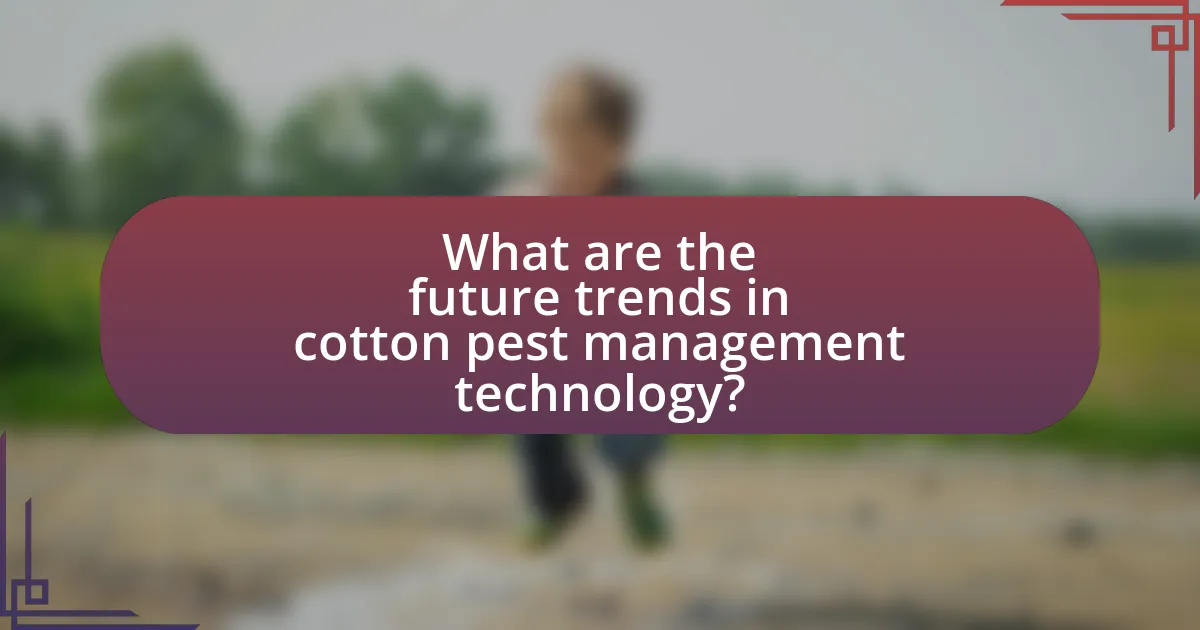
What are the future trends in cotton pest management technology?
Future trends in cotton pest management technology include the increased use of precision agriculture, biotechnology, and integrated pest management (IPM) strategies. Precision agriculture utilizes data analytics and remote sensing to monitor pest populations and crop health, allowing for targeted interventions that reduce pesticide use and enhance efficiency. Biotechnology advancements, such as genetically modified cotton varieties that are resistant to specific pests, are expected to play a significant role in reducing reliance on chemical pesticides. Additionally, IPM strategies that combine biological control methods, cultural practices, and chemical applications are gaining traction, promoting sustainable pest management practices. These trends are supported by research indicating that integrating technology can lead to improved pest control outcomes and higher cotton yields.
How is precision agriculture shaping the future of pest management?
Precision agriculture is revolutionizing pest management by utilizing data-driven technologies to enhance decision-making and resource allocation. This approach allows farmers to monitor pest populations in real-time through tools such as drones, sensors, and satellite imagery, enabling targeted interventions rather than blanket pesticide applications. For instance, studies have shown that precision agriculture can reduce pesticide use by up to 30% while maintaining crop yields, as it facilitates the application of pest control measures only when and where they are needed. This not only minimizes environmental impact but also promotes sustainable farming practices, aligning with the increasing demand for eco-friendly agricultural methods.
What advancements in drone technology are being utilized for pest control?
Advancements in drone technology for pest control include the use of high-resolution imaging, multispectral sensors, and automated spraying systems. High-resolution imaging allows for precise identification of pest infestations and crop health, enabling targeted interventions. Multispectral sensors can detect variations in plant health that indicate pest presence, facilitating early detection and management. Automated spraying systems equipped on drones enable efficient application of pesticides, reducing chemical use and minimizing environmental impact. These technologies collectively enhance pest management strategies in cotton farming, leading to improved yields and sustainable practices.
How can artificial intelligence enhance pest management strategies?
Artificial intelligence can enhance pest management strategies by enabling precise monitoring and predictive analytics. AI algorithms analyze data from various sources, such as satellite imagery and sensor networks, to identify pest populations and predict outbreaks. For instance, a study published in the journal “Computers and Electronics in Agriculture” demonstrated that machine learning models could accurately forecast pest infestations, leading to timely interventions and reduced pesticide use. This data-driven approach not only improves the efficiency of pest control measures but also promotes sustainable agricultural practices by minimizing environmental impact.
What best practices should farmers adopt for effective pest management?
Farmers should adopt integrated pest management (IPM) practices for effective pest management. IPM combines biological, cultural, physical, and chemical tools to minimize pest damage while reducing risks to human health and the environment. Research indicates that IPM can reduce pesticide use by 50% or more, leading to cost savings and improved crop yields. For instance, a study published in the Journal of Economic Entomology found that cotton farmers implementing IPM strategies experienced a 20% increase in yield compared to those using conventional methods. Additionally, monitoring pest populations and using resistant crop varieties are essential components of IPM that enhance its effectiveness.
How can farmers integrate technology into their existing pest management plans?
Farmers can integrate technology into their existing pest management plans by utilizing precision agriculture tools, such as drones and sensors, to monitor pest populations and crop health in real-time. These technologies enable farmers to collect data on pest activity and environmental conditions, allowing for targeted interventions rather than blanket pesticide applications. For instance, a study published in the journal “Agricultural Systems” found that using drones equipped with multispectral cameras improved pest detection accuracy by 30%, leading to more efficient pest control measures. By adopting these technological solutions, farmers can enhance their pest management strategies, reduce chemical usage, and ultimately improve crop yields.
What resources are available for farmers to stay updated on pest management advancements?
Farmers can utilize various resources to stay updated on pest management advancements, including agricultural extension services, online platforms, and research publications. Agricultural extension services provide localized information and training on pest management practices, while online platforms such as the Integrated Pest Management (IPM) website offer access to the latest research and pest alerts. Additionally, peer-reviewed journals like the Journal of Economic Entomology publish studies on pest management innovations, ensuring farmers have access to scientifically validated information. These resources collectively enhance farmers’ knowledge and application of effective pest management strategies.
